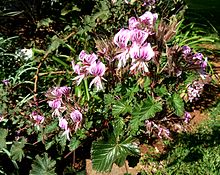Pelargonium cordifolium
| Pelargonium cordifolium | |
|---|---|

| |
| Scientific classification | |
| Kingdom: | |
| (unranked): | |
| (unranked): | |
| (unranked): | |
| Order: | |
| Family: | |
| Genus: | |
| Species: | Pelargonium cordifolium
|
| Binomial name | |
| Pelargonium cordifolium | |
| Synonyms | |
|
Pelargonium cordatum | |
Pelargonium cordifolium is a pelargonium species native to South Africa. It is in the subgenus pelargonium along with Pelargonium crispum and Pelargonium tomentosum.
Etymology
Pelargonium comes from the Greek; Pelargos which means Stork. Another name for pelargoniums is storksbills due the shape of their fruit. Cordifolium refers to the heart shaped leaves (Cordi- means heart in Latin).
Description
Pelargonium cordifolium is a large, spreading species, growing up to 1.5 metres tall. It is a hairy plant with a slight apple scent and pale pink flowers with dark veins from March to July. Its leaves are dark green in colour and it has wide, heart shaped leaves with lobed edges.
Cultivars and hybrids
There are a few cultivars and hybrids of Pelargonium cordifolium. These include:
- Pelargonium cordifolium var. rubrocinctum - A variety of P.cordifolium with slightly paler leaves and reddish - pink flowers with maroon veins.
- Pelargonium cordifolium 'Caroline's Citrine' - A variety of P.cordifolium with golden leaves and dark blotches in the centre.
- Pelargonium cordifolium 'Donn's Goldstrike' - A variety of P.cordifolium with golden leaves similar to P.'Caroline's Citrine' but without the dark green blotches.
Uses
As well as being a wonderful houseplant or outdoor perennial depending on your climate, Pelargonium cordifolium's leaves can be in Potpourri.
References
